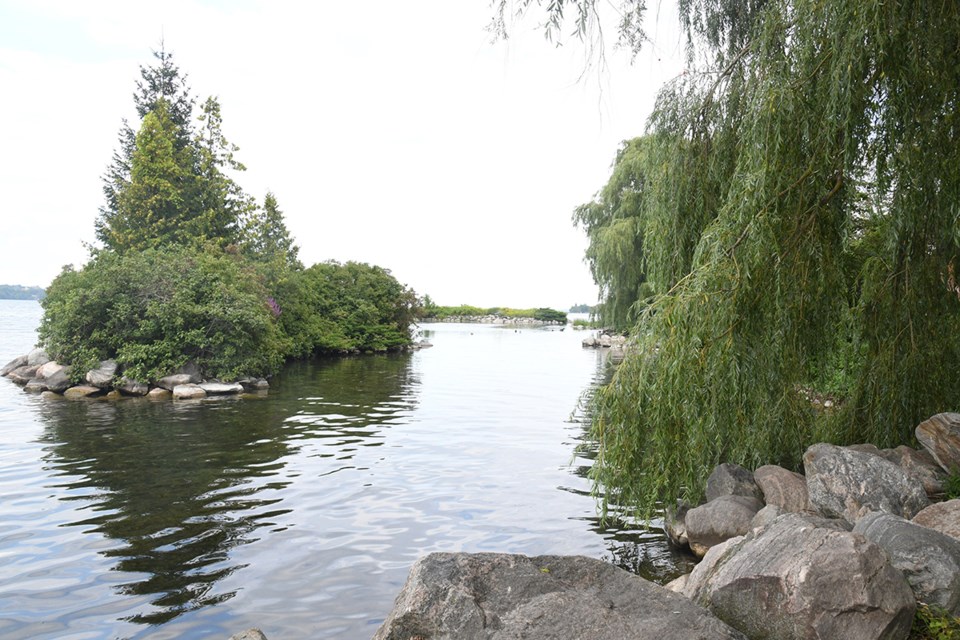A shoreline refuge for the weary runner, book reader or contemplative walker is close at hand.
Allandale Station Park, located between the Southshore Centre and Tiffin Launch, is another little gem in Barrie’s bayside crown.
The 16.3-acre waterfront site has walking/biking trails, fitness stations and the Kiwanis Club of Barrie picnic gazebo.
With plenty of benches — many of them dedicated to loved ones and friends — it’s a great place to relax and enjoy the view.
Down at the water’s edge is a whole other community that has stopped by to relax but they’re probably not checking out the skyline.
The Rotary Islands — Allandale Station Park’s main attraction for birds, fish and other lakeside critters — was an environment enhancement project by the Rotary Club of Barrie between that was completed in 2000.
To offset deterioration of shoreline habitat in Kempenfelt Bay, the city and club members worked alongside the Ministry of Natural Resources (now called the Ministry of Natural Resources and Forestry) to create a functional habitat restoration project.
Two manmade islands surround a sheltered lagoon for fish, waterfowl and amphibians to live while hundreds of indigenous shrubs and plants — now firmly established after 20 years — were planted to enhance the natural health of the habitat for wildlife.
The project was made possible by Rotary funding and the donation of materials, heavy construction equipment and manpower from area construction and supply companies, according to Rotarian Peter Gill, a landscape and resource management consultant who designed the layout of the islands.
“Approximately 4,200 cubic metres of uncontaminated rock, concrete rubble, top soil and sub-grade material went into creating the islands,” he says. “Most of the material was donated and stockpiled for the project by area contractors during the previous fall and winter before construction began.”
MNR biologist Robin Craig said at the time that good shore-zone habitat for fish and wildlife had been disappearing rapidly around Lake Simcoe.
“The shallow water here is potentially good habitat, but it has lacked the necessary protection from boaters, ice and wave action,” he says. “The lack of heavy-duty shade trees, shoreline shrubbery and over-hanging shelter along the south shore results in the shallow water being too exposed and warm for good habitat. Hence the Rotary Islands.”
The site is based on a sediment shelf, which extends along the south shore, creating relatively shallow water for about 150 metres out from the existing shoreline.
Gill says there was much preparation done before the islands could be created, not the least of which was the use of some yuletide leftovers.
“We drilled holes in the ice to confirm the depth of the water and then laid out a pattern of the future islands with Christmas trees,” he says.
Now, after 20 years, Mother Nature has taken over what the Rotarians started.
“The islands, armoured with heavy boulders against wave and ice action, have created a sheltered lagoon in the shallow water just offshore,” Gill says. “Submerged rock piles, bank covers, shade trees, shrubs and a variety of aquatic plants have provided conditions to encourage a variety of small prey fish to spawn there and to frequent the area in search of food and shelter.
“In turn, larger predator fish, attracted and sustained by the new food supply and habitat, have benefited accordingly and enhanced sport fishing opportunities in the bay.”
While taking a break from whatever waterfront activity tickles your fancy — whether fishing, dog walking, reading, or running — you’ll probably end up sitting down on one of Allandale Station Park's dedicated benches.
Each one, like benches in parks across the city, has its own story and are part of the city’s commemorative program, which allows residents and visitors to pay tribute to a person or occasion within the city’s public land.
Residents may donate a commemorative bench, tree or stone in memory of a loved one or for a number of other different reasons — a graduation, a retirement, an anniversary or any other special occasion.



